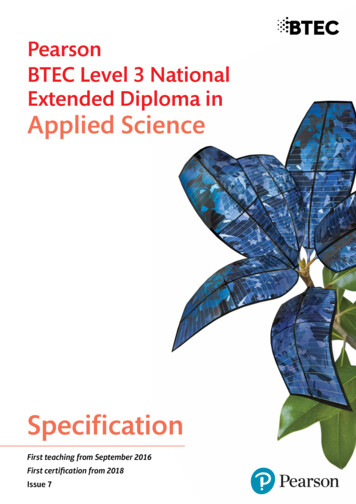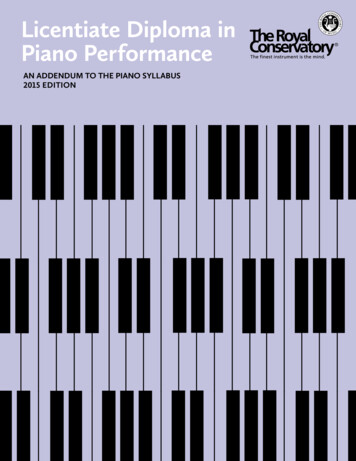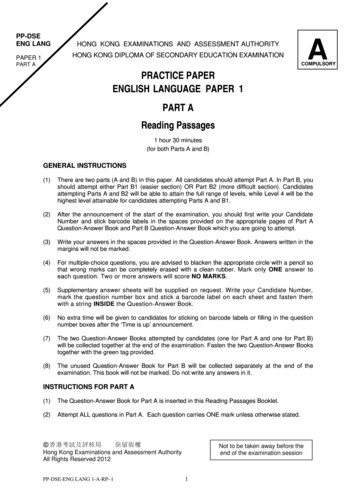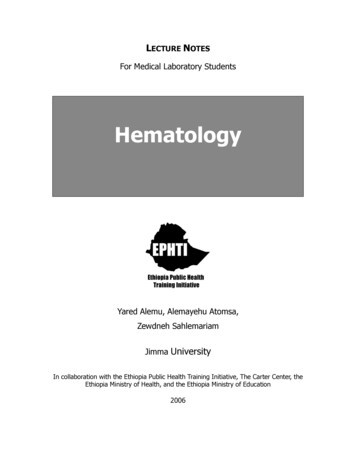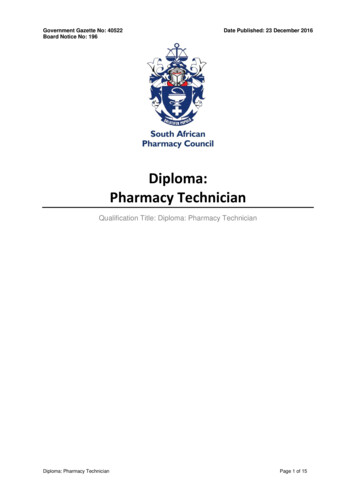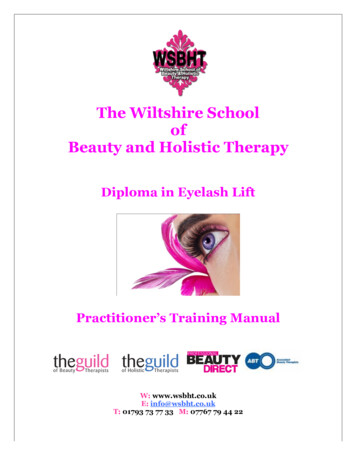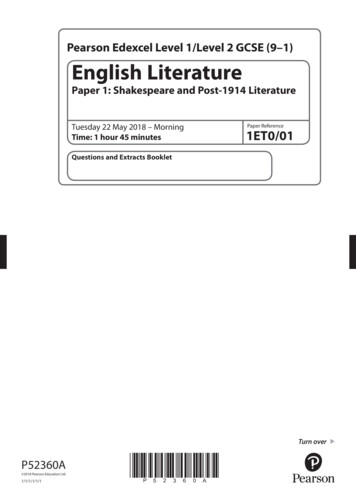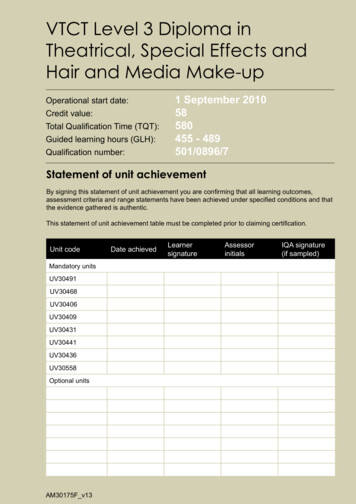
Transcription
VTCT Level 3 Diploma inTheatrical, Special Effects andHair and Media Make-up1 September 2010Credit value: 58Total Qualification Time (TQT):580Guided learning hours (GLH):455 - 489Qualification number: 501/0896/7Operational start date:Statement of unit achievementBy signing this statement of unit achievement you are confirming that all learning outcomes,assessment criteria and range statements have been achieved under specified conditions and thatthe evidence gathered is authentic.This statement of unit achievement table must be completed prior to claiming certification.Unit codeMandatory 0436UV30558Optional unitsAM30175F v13Date achievedLearnersignatureAssessorinitialsIQA signature(if sampled)
The qualificationIntroductionThe VTCT Level 3 Diploma in Theatrical,Special Effects and Hair and Media Make-upis a qualification that has been specificallydesigned to develop your practical skills to anadvanced level through a variety of techniquesin the following units; media, special effects andcamouflage make-up, how to apply ready-madesmall prosthetic pieces and bald caps, monitorand maintain health and safety, client care andcommunication, style and fit a postiche and howto apply the complex skill of airbrush make-up.To further enhance your practical skills youwill have the opportunity to choose from thefollowing hairdressing and beauty units; createand cast small prosthetic pieces and bald caps,working in beauty related industries, face andbody art, styling and dressing hair, fantasyhair design, production arts planning, applyindividual permanent lashes, self tanning,eyelash and brow treatments, Mendhi skindecoration, 2D visual communication, cutwomen’s hair, creative hairdressing designskills, hair extension services, eyelash perming,ear piercing, hair removal using either wax,sugar or threading, facial skin care, instructionon make-up application, create an image usinghair and beauty techniques, wig services, makestyle a hair addition or bridal hairstyling.The purpose of this qualification is to developyour skills as a professional make-up artistworking with performers to a high level ofoccupational ability, to enable you to providehair and make-up services in the media, theatre,performing arts, fashion and photographicindustries. It also provides a sound platform forfurther learning.2National Occupational Standards (NOS)Units in this qualification have been mappedto the relevant NOS (where applicable). Thisqualification is regulated on the RegulatedQualifications Framework.This qualification is approved and supported bythe Hairdressing and Beauty Industry Authority(HABIA), the standard setting body for hair,beauty, nails and spa qualifications.PrerequisitesLearners who wish to undertake thisqualification must also achieve the VTCT(ITEC) Level 2 Award in Infection Prevention(COVID-19) for Make-up Services qualificationor a regulated equivalent.Your centre will have ensured that you havethe required knowledge, understanding andskills to enrol and successfully achieve thisqualification.
ProgressionOn completion of this qualification you maychoose to undertake further study; qualificationsyou could progress to include:NVQ qualifications; VTCT Level 3 NVQ Diploma in BeautyTherapy General VTCT Level 3 NVQ Diploma in BeautyTherapy Make-Up VTCT Level 3 NVQ Diploma inHairdressingAlternatively, you may wish to seek employmentas: VTCT Level 3 Award in Bridal Hairstyling VTCT Level 3 Certificate in Creative HairDesign VTCT Level 3 Certificate in HairExtensions Services VTCT Level 3 Diploma in Beauty TherapyTreatments VTCT Level 3 Diploma in Women’sHairdressing VTCT Level 4 Award in Advanced HairStyling VTCT Level 4 Certificate in Specialist Hairand Scalp Services VTCT Level 4 Diploma in AdvancedBeauty Therapy3
Qualification structureTotal credits required - 58 (minimum)All mandatory units must be completed. All 58 credits must be achieved, of which, a minimum of45 credits must at or above Level 3.Mandatory units -4445 creditsVTCTunit codeOfqual unitreferenceUnit titleCreditvalueGLHLevelUV30491R/600/8780Monitor and maintain health and safetypractice in the salon4293UV30468T/601/4457Client care and communication in beautyrelated industries3283UV30406R/601/3932Apply airbrush make-up to the face4273UV30409D/601/4355Camouflage make-up7603UV30431T/601/3566Media make-up7603UV30441M/601/5509Fashion and photographic make-up7663UV30436R/601/5339Style and fit postiche7603UV30558M/601/9432Apply prosthetic pieces and bald caps6403
Optional units -13 (minimum) creditsVTCTunit codeOfqual unitreferenceUnit titleCreditvalueGLHLevelUV20415T/601/5642Working in beauty related industries4312UV20419F/601/3554Provide eyelash and brow treatments4362UV20444H/601/5491Design and apply Mendhi skin decoration4342UV20473H/601/5877Provide eyelash perming2202UV20439F/601/5482Provide ear piercing2172UV20418J/601/3555Remove hair using waxing techniques6572UV20442D/601/5487Provide threading services for hair removal4292UV20446A/601/4217Remove hair using sugaring4292UV20398A/601/3987Provide facial skin care7562UV20438L/601/4223Instruction on make-up application5342UV20499J/600/8632Create an image based on a theme withinthe hair and beauty sector7602UV20503A/601/5366Wig services5402UV30557R/601/9441Create and cast small prosthetic piecesand bald caps6403UV30440J/601/5466Design and apply face and body art6513UV30496R/600/8634Style and dress hair using a variety oftechniques7603UV30572K/502/5624Fantasy hair design for performers10603UV30571M/600/0136Production arts planning10603UV30426D/601/3562Apply individual permanent lashes4383UV30451R/601/4465Provide self tanning3253UV30495Y/600/8635Cut women’s hair to create a variety oflooks8753UV30498H/600/8637Creative hairdressing design skills8603UV30380A/600/9034Provide hair extension services5453UV30500K/600/8638Make and style a hair addition7603UV30510K/600/9059Bridal hairstyling4373UV21365L/502/48232D visual communication530255
Guidance on assessmentThis book contains the mandatory units that make up this qualification. Optional units will beprovided in additional booklets (if applicable). Where indicated, VTCT will provide assessmentmaterials. Assessments may be internal or external. The method of assessment is indicated ineach unit.Internal assessment(any requirements will be shown in the unit)Assessment is set, marked and internallyquality assured by the centre to clearlydemonstrate achievement of the learningoutcomes. Assessment is sampled by VTCTexternal quality assurers.External assessment(any requirements will be shown in the unit)This only applies to mandatory units in thisqualification. Paper 1 of 1 and Paper 2 of 2must be completed for all optional units (whereapplicable).Assessment explainedExternally assessed hard-copy question paperswill be set by VTCT, marked by centre staff andsampled by VTCT external quality assurers.VTCT qualifications are assessed and qualityassured by centre staff. Work will be set toimprove your practical skills, knowledge andunderstanding. For practical elements, you willbe observed by your assessor. All your workmust be collected in a portfolio of evidence andcross-referenced to requirements listed in thisrecord of assessment book.External anatomy and physiologypapersYour centre will have an internal quality assurerwhose role is to check that your assessmentand evidence is valid and reliable and meetsVTCT and regulatory requirements.Externally assessed question paperscompleted electronically will be set and markedby VTCT.Some units in this qualification contain a Paper2 of 2, which assess anatomy and physiologyonly.Rather than complete an individual anatomyand physiology paper (Paper 2 of 2) for everyunit, you can complete one external paper thatcovers all anatomy and physiology papers inthis qualification.The external paper title in Linx2Achieve is: 6 6Once these papers have been achieved allunit external papers titled ‘Paper 2 of 2’ can besigned off by your assessor.VRQ 3 Theatrical, Special Effectsand Hair and Media Make-UpMandatory Anatomy and PhysiologyAn external quality assurer, appointed byVTCT, will visit your centre to sample andquality-check assessments, the internal qualityassurance process and the evidence gathered.You may be asked to attend on a different dayfrom usual if requested by the external qualityassurer.This record of assessment book is yourproperty and must be in your possession whenyou are being assessed or quality assured. Itmust be kept safe. In some cases your centrewill be required to keep it in a secure place.You and your course assessor will togethercomplete this book to show achievement of alllearning outcomes, assessment criteria andranges.
Creating a portfolio of evidenceAs part of this qualification you are required toproduce a portfolio of evidence. A portfolio willconfirm the knowledge, understanding and skillsthat you have learnt. It may be in electronic orpaper format.Your assessor will provide guidance on how toprepare the portfolio of evidence and how toshow practical achievement, and understandingof the knowledge required to successfullycomplete this qualification. It is this bookletalong with the portfolio of evidence that willserve as the prime source of evidence for thisqualification.Evidence in the portfolio may take the followingforms: Observed workWitness statementsAudio-visual mediaEvidence of prior learning or attainmentWritten questionsOral questionsAssignmentsCase studiesAll evidence should be documented in theportfolio and cross referenced to unit outcomes.Constructing the portfolio of evidence should notbe left to the end of the course.7 7
Unit assessment methodsThis section provides an overview of the assessment methods that make up each unit in thisqualification. Detailed information on assessment is provided in each unit.Mandatory unitsExternalVTCT unitcodeUnit Portfolio ofEvidenceMonitor and maintain health andsafety practice in the salon0 UV30468Client care and communication inbeauty-related industries0 UV30406Apply airbrush make-up to the face1UV30409Camouflage make-up2UV30431Media make-up0 UV30441Fashion and photographic makeup1 UV30436Style and fit postiche0 UV30558Apply prosthetic pieces and baldcaps0 Optional unitsExternal88VTCT unitcodeUnit Portfolio ofEvidenceWorking in beauty relatedindustries0 UV20419Provide eyelash and browtreatments1 UV20444Design and apply Mendhi skindecoration0 UV20473Provide eyelash perming0UV20439Provide ear piercing1
Unit assessment methodsOptional units - (continued)ExternalVTCT unitcodeUnit Portfolio ofEvidenceRemove hair using waxingtechniques1 UV20442Provide threading services for hairremoval0 UV20446Remove hair using sugaring0UV20398Provide facial skin care2UV20438Instruction on make-up application0 UV20499Create an image based on a themewithin the hair and beauty sector0 UV20503Wig services1 UV30557Create and cast small prostheticpieces and bald caps0 UV30440Design and apply face and bodyart0 UV30496Style and dress hair using a variety oftechniques1 UV30572Fantasy hair design for performers0UV30571Production arts planning0UV30426Apply individual permanent lashes1UV30451Provide self tanning1 UV30495Cut women’s hair to create avariety of looks1 UV30498Creative hairdressing design skills0UV30380Provide hair extension services0UV30500Make and style a hair addition0UV30510Bridal hairstyling1UV213652D visual communication0 99
Unit glossaryDescription10VTCT productcodeAll units are allocated a unique VTCT product code for identification purposes.This code should be quoted in all queries and correspondence to VTCT.Unit titleThe title clearly indicates the focus of the unit.NationalOccupationalStandards(NOS)NOS describe the skills, knowledge and understanding needed to undertake aparticular task or job to a nationally recognised level of competence.LevelLevel is an indication of the demand of the learning experience, the depth and/orcomplexity of achievement and independence in achieving thelearning outcomes.Credit valueThis is the number of credits awarded upon successful achievement of all unitoutcomes. Credit is a numerical value that represents a means of recognising,measuring, valuing and comparing achievement.GuidingLearning hours(GLH)The activity of a learner in being taught or instructed by - or otherwiseparticipating in education or training under the immediate guidance or supervisionof - a lecturer, supervisor, tutor or other appropriate provider of education ortraining.Totalqualificationtime (TQT)The number of hours an awarding organisation has assigned to a qualification forGuided Learning and an estimate of the number of hours a learner will reasonably belikely to spend in preparation, study, or any other form of participation in education ortraining. This includes assessment, which takes place as directed - but, unilke GuidedLearning, not under the immediate guidance or supervision of - a lecturer, supervisor,tutor or other appropriate provider of education or training.ObservationsThis indicates the minimum number of competent observations, per outcome,required to achieve the unit.LearningoutcomesThe learning outcomes are the most important component of the unit, they set outwhat is expected in terms of knowing, understanding and practicalability as a result of the learning process. Learning outcomes are the results oflearning.EvidencerequirementsThis section provides guidelines on how evidence must be gathered.Maximumservice timesThe maximum time in which a particular service or practical element must becompleted.ObservationoutcomeAn observation outcome details the practical tasks that must be completed toachieve the unit.KnowledgeoutcomeA knowledge outcome details the theoretical requirements of a unit that mustbe evidenced through oral questioning, a mandatory written question paper orportfolio of evidence.AssessmentcriteriaAssessment criteria set out what is required, in terms of achievement, to meeta learning outcome. The assessment criteria and learning outcomes are thecomponents that inform the learning and assessment that should take place.Assessment criteria define the standard expected to meet learning outcomes.RangeThe range indicates what must be covered. Ranges must be practicallydemonstrated in parallel to the unit’s observation outcomes.
UV30491Monitor and maintain healthand safety practice in the salonThrough this unit you will develop your skills in asupervisory role focusing on health and safety within yoursalon.You will recognise salon hazards, carry out riskassessments and then implement the necessary actions.You will monitor and support your colleagues to ensureyour salon complies with health and safety requirements.You will implement and supervise salon procedures for allaspects of salon safety and security including the need forinsurance.UV30491 v10
Level3Credit value4GLH29Observation(s)2External paper(s)0
Monitor and maintain healthand safety practice in the salonLearning outcomesOn completion of this unit you will:1.2.Evidence requirements1.EnvironmentEvidence for this unit must be gathered in areal or realistic working environment.2.SimulationSimulation is not allowed in this unit. All‘Observation’ outcomes must be on realclients.3.Observation outcomesCompetent performance of ‘Observation’outcomes must be demonstrated to yourassessor on at least two occasions.4.Knowledge outcomesThere must be evidence that you possessall the knowledge and understandinglisted in the ‘Knowledge’ section of thisunit. This evidence may include projects,assignments, case studies, reflectiveaccounts, oral/written questioning and/orother forms of evidence.5.Tutor/Assessor guidanceYou will be guided by your tutor/assessoron how to achieve learning outcomes in thisunit. All outcomes must be achieved.6.External paperThere is no external paper requirement forthis unit.Be able to carry out a risk assessmentBe able to monitor health and safety inthe salonUV3049113
Achieving observationsand rangeAchieving observation outcomesYour assessor will observe your performanceof practical tasks. The minimum numberof observations required is indicated in theevidence requirements section of this unit.Criteria may not always naturally occur duringa practical observation. In such instances youwill be asked questions to demonstrate yourcompetence in this area. Your assessor willdocument the criteria that have been achievedthrough oral questioning.Your assessor will sign off an outcome when allcriteria have been competently achieved in asingle client service.Achieving rangeThere are no range statements that apply to thisunit.14UV30491Maximum service timesThere are no maximum service times that applyto this unit.
ObservationsOutcome 1Be able to carry out a risk assessmentYou can:a.Carry out risk assessments and takenecessary actions*May be assessed through oral questioning.Observation12OptionalDate achievedCriteria questioned orallyPortfolio referenceAssessor initialsLearner signatureUV3049115
Outcome 2Be able to monitor health and safety in the salonYou can:a.Monitor and support the work of others toensure compliance with health and safetyrequirements*May be assessed through oral questioning.ObservationDate achievedCriteria questioned orallyPortfolio referenceAssessor initialsLearner signature16UV3049112Optional
Developing knowledgeAchieving knowledge outcomesYou will be guided by your tutor and assessoron the evidence that needs to be produced.Your knowledge and understanding will beassessed using the assessment methods listedbelow: Where possible your assessor will integrateknowledge outcomes into practical observationsthrough oral questioning.Observed workWitness statementsAudio-visual mediaEvidence of prior learning or attainmentWritten questionsOral questionsAssignmentsCase studiesUV3049117
KnowledgeOutcome 1Be able to carry out a risk assessmentYou can:b.State the reason for carrying out risk assessmentsc.Describe the procedures for carrying out a risk assessmentd.Describe when risk assessments should be carried oute.Outline necessary actions to take following a risk assessment* Assessor initials to be inserted if orally questioned.Requirements highlighted in white are assessed in the external paper.18UV30491Portfolio reference /Assessor initials*
Outcome 2Be able to monitor health and safety in the salonYou can:b.Outline the health and safety support that should be provided tostaffc.Outline procedures for dealing with different types of securitybreachesd.Explain the need for insurancePortfolio reference /Assessor initials** Assessor initials to be inserted if orally questioned.Requirements highlighted in white are assessed in the external paper.UV3049119
Unit contentThis section provides guidance on the recommended knowledge and skills required to enable youto achieve each of the learning outcomes in this unit. Your tutor/assessor will ensure you have theopportunity to cover all of the unit content.Outcome 1: Be able to carry out a risk assessmentHazards and risks: A hazard is somethingthat has the potential to cause harm, a riskis the likelihood of a hazard happening.Reasons for risk assessment: Legalrequirement, provide a safe environmentfor staff/visitor/clients, identification ofhazards, minimising hazards and risks,emergency procedures, staff training,implication of more than five membersof staff, new staff in the workplace, newequipment and products, review systems,amendments and modifications to existingassessments, update records.Salon procedure for risk assessments:Identify hazard, judgement of salonhazards, nominated risk assessmentperson/team, who/what, determine thelevel of risk, preventative measures,reduce a potentially harmful situation, notifystaff, interpret results, conclusions, recordfindings, regular reviews.Potential salon hazards requiringregular risk assessment:Space – utilisation, working area, heating,lighting, ventilation, layout and design ofthe salon.Chemicals – procedures, storage,handling, safe usage, safe disposal,records.Equipment – selection, safe usage,handling, lifting, repairs, maintenance.Security (stock) – control systems,procedures, ordering, handling, storage.20UV30491Security (cash) – staff training, point ofsale, in transit.Security (people) – staff clients, visitors,personal belongings, systems, security,emergency evacuation, storage/use ofconfidential staff/client records, businessinformation, data protection.Buildings – maintenance of internal andexternal security, commercially availablesystems.Emergency procedures – accidents, firstaid, fire evacuation, incidents, personnel,records.
Outcome 2: Be able to monitor health and safety in the salonSalon health and safety legislationand regulations: Health and safety atwork, control of substances hazardousto health, reporting of injuries diseasesand dangerous occurrences, personalprotective equipment, electricity at work,manual handling, supply of goods andservices, trade description, data protection,employers liability (compulsory insurance),occupiers liability, local by-laws (set bycouncil), salon rules, code of conduct,observance by all staff.Monitor and support others to ensurecompliance of health and safety:Accurate records, update processesand procedures, regular staff training(simulation), spot checks, monitoringchanges in law, take external advice.Providing support for staff: Up-to-dateleaflets and posters, ongoing training, opendoor policy, suggestion box, current rolesand responsibilities for staff.Security breaches:Inform - salon owner, management, headof school.Review records - stock levels/control,monitor takings, inventory of equipment,manual and computerised records.Actions - take statements, eye witnessaccounts, review findings, call in police,notify data protection registry/clients ofbreach, maintain confidentiality, couldresult in loss of employment.Importance of insurance: Accidents,emergencies, legal claim, protect business,prevent fraudulent claim.UV3049121
NotesUse this area for making notes and drawing diagrams22UV30491
UV30468Client care and communicationin beauty-related industriesThis is a preparation for work unit which is based oncapability and knowledge. This unit is about client careand communication in beauty-related industries. You willdevelop your ability to adapt the provision of client careand your communication skills, to the needs of differentclients, as well as learn how to manage client expectations.UV30468 v10
Level3Credit value3GLH28Observation(s)3External paper(s)0
Client care and communicationin beauty-related industriesLearning outcomesOn completion of this unit you will:1.2.Be able to communicate and behave ina professional manner when dealing withclientsEvidence requirements1.EnvironmentEvidence for this unit must be gathered in areal or realistic working environment.2.SimulationSimulation is not allowed in this unit.3.Observation outcomesCompetent performance of ‘Observation’outcomes must be demonstrated to yourassessor on at least three occasions.4.RangeAll ranges must be practically demonstratedor other forms of evidence produced toshow they have been covered.5.Knowledge outcomesThere must be evidence that you possessall the knowledge and understandinglisted in the ‘Knowledge’ section of thisunit. This evidence may include projects,assignments, case studies, reflectiveaccounts, oral/written questioning and/orother forms of evidence.6.Tutor/Assessor guidanceYou will be guided by your tutor/assessoron how to achieve learning outcomes andranges in this unit. All outcomes and rangesmust be achieved.7.External paperThere is no external paper requirement forthis unit.Be able to manage client expectationsUV3046825
Achieving observationsand rangeAchieving observation outcomesYour assessor will observe your performanceof practical tasks. The minimum numberof observations required is indicated in theevidence requirements section of this unit.Criteria may not always naturally occur duringa practical observation. In such instances youwill be asked questions to demonstrate yourcompetence in this area. Your assessor willdocument the criteria that have been achievedthrough oral questioning.Your assessor will sign off an outcome when allcriteria have been competently achieved in asingle client service.Achieving rangeThe range section indicates what mustbe covered. Ranges should be practicallydemonstrated as part of an observation. Wherethis is not possible other forms of evidence maybe produced. All ranges must be covered.Your assessor will document the portfolioreference once a range has been competentlyachieved.26UV30468Maximum service timesThere are no maximum service times that applyto this unit.
ObservationsOutcome 1Be able to communicate and behave in a professional mannerwhen dealing with clientsYou can:a.Behave in a professional manner within theworkplaceb.Use effective communication techniqueswhen dealing with clientsc.Adapt methods of communication to suitdifferent situations and client needsd.Use effective consultation techniques toidentify treatment objectivese.Provide clear recommendations to the client*May be assessed through oral questioning.Observation123Date achievedCriteria questioned orallyPortfolio referenceAssessor initialsLearner signatureUV3046827
HabiaOutcome 2Be able to manage client expectationsYou can:a.Maintain client confidentiality in line withlegislationb.Use retail sales techniques to meet clientrequirements*May be assessed through oral questioning.ObservationDate achievedCriteria questioned orallyPortfolio referenceAssessor initialsLearner signature28UV30468123
Range*You must practically demonstrate that you have:Dealt with all clientsPortfolio referenceNewRegularUsed all consultation techniquesPortfolio referenceQuestioningVisualManualDealt with all complaintsPortfolio referenceDissatisfied clientUnrealistic client expectations*It is strongly recommended that all range items are practically demonstrated. Where this is notpossible, other forms of evidence may be produced to demonstrate competence.UV3046829
Developing knowledgeAchieving knowledge outcomesYou will be guided by your tutor and assessoron the evidence that needs to be produced.Your knowledge and understanding will beassessed using the assessment methods listedbelow: 30Observed workWitness statementsAudio-visual mediaEvidence of prior learning or attainmentWritten questionsOral questionsAssignmentsCase studiesUV30468Where possible your assessor will integrateknowledge outcomes into practical observationsthrough oral questioning.
KnowledgeOutcome 1Be able to communicate and behave in a professional mannerwhen dealing with clientsYou can:f.Assess the advantages and disadvantages of different types ofcommunication used with clientsg.Describe how to adapt methods of communication to suit the clientand their needsh.Explain what is meant by the term ‘professionalism’ within beautyrelated industriesi.Explain the importance of respecting a client’s ‘personal space’j.Describe how to use suitable consultation techniques to identifytreatment objectivesk.Explain the importance of providing clear recommendations to theclientPortfolio reference /Assessor initials** Assessor initials to be inserted if orally questioned.Requirements highlighted in white are assessed in the external paper.UV3046831
HabiaOutcome 2Be able to manage client expectationsYou can:c.Evaluate client feedbackd.Evaluate measures used to maintain client confidentialitye.Explain the importance of adapting retail sales techniques to meetclient requirementsf.Identify methods of improving own working practicesg.Describe how to resolve client complaints* Assessor initials to be inserted if orally questioned.Requirements highlighted in white are assessed in the external paper.32UV30468Portfolio reference /Assessor initials*
Unit contentThis section provides guidance on the recommended knowledge and skills required to enable youto achieve each of the learning outcomes in this unit. Your tutor/assessor will ensure you have theopportunity to cover all of the unit content.Outcome 1: Be able to communicate and behave in a professional mannerwhen dealing with clientsVerbal communication: (speaking)manner and tone, professional, supportive,respectful, sensitive to client, openquestioning related to treatment.Advantages – quick, instant response,client body language.Disadvantages – no written record, notime to consider, no paper trail.Non-verbal communication: eye contact,body language, listening.Advantages – written communication,detailed, recorded, clear, specific,opportunity to consider, paper trail.Body language – expression of feelings,easily identify anger, happiness, confusion.Disadvantages – written communication,cannot see reaction, cannot change mind,no opportunity for discussion.Body language – cannot hide feelings,can be a barrier.Professional manner: Use positive bodylanguage, abide by salon regulations andcodes of conduct, encourage clients to askquestions, be supportive and respectful, besensitive to client’s privacy and personaldetails, professional appearance, avoidinappropriate conversations.Professional appearance: Clean,professional uniform, no jewellery orpiercings, hair neatly tied back (fringesecured), closed-in footwear, personalhygiene and cleanliness (shower/bath,cover cuts and abrasions, deodorant orantiperspirant), oral hygiene (clean teeth,fresh breath), nails (good condition andmaintained, short, no nail varnish, no nailextensions).Professional ethical conduct: Polite,cheerful and friendly manner; friendly facialexpressions, positive attitude, eye contact,open body language, client
This book contains the mandatory units that make up this qualification. Optional units will be provided in additional booklets (if applicable). Where indicated, VTCT will provide assessment materials. Assessments may be internal or external. The method of
